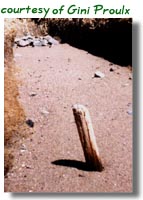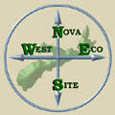With species such as maple (sugar, red), birch (yellow,
white), spruce (white, black, red), pine (white, jack, red) as well as oak, elm, fir,
beech and hemlock, our forests are truly mixed. Nova Scotia has been an area of active
logging longer than any other forest in North America. The long history of logging means
that our trees are not as large as in other areas of the country. However, we do have some
stands that have been preserved (mainly in Kejimkujik and the Tobeatic) and remain special
places to enjoy. While we think that any forest is special, we feel that there are two
spots that will be of particular interest to visitors.
 Hemlocks
& Hardwoods Trail
Hemlocks
& Hardwoods Trail
This is a 6-km loop in Kejimkujik National Park that winds
through a 300-year-old hemlock forest. The trail provides an excellent opportunity to view some
large old-growth trees as well as some unique adaptations such as the one pictured here.
The hemlock forest is quite open (from tree to tree) with a broad, high canopy which keeps
the needle- and moss-covered forest floor shaded.
Hemlock trees (Tsuga canadenisis) are large conifers
with shiny dark-green, flat needles. Trunks taper as the tree rises, the reddish
brown bark becomes marked by deep vertical grooves, and the grooves deepen with age. The
main branches grow in a staggered pattern, not in regular groups as with other conifers.
Sunken Forest
At the Head of St. Mary's Bay, the continual erosion of
coast line has exposed the preserved stumps of beech and pine trees rooted in podzol
soil, some more than a metre in diameter that were submerged when sea levels began to rise
over 8,000 years ago. This forest formed when sea levels were lower. With a rise in sea
levels, these forests became submerged and later while the upper portions of the trees
decayed, depositional materials settled out covering and preserving the stumps.




